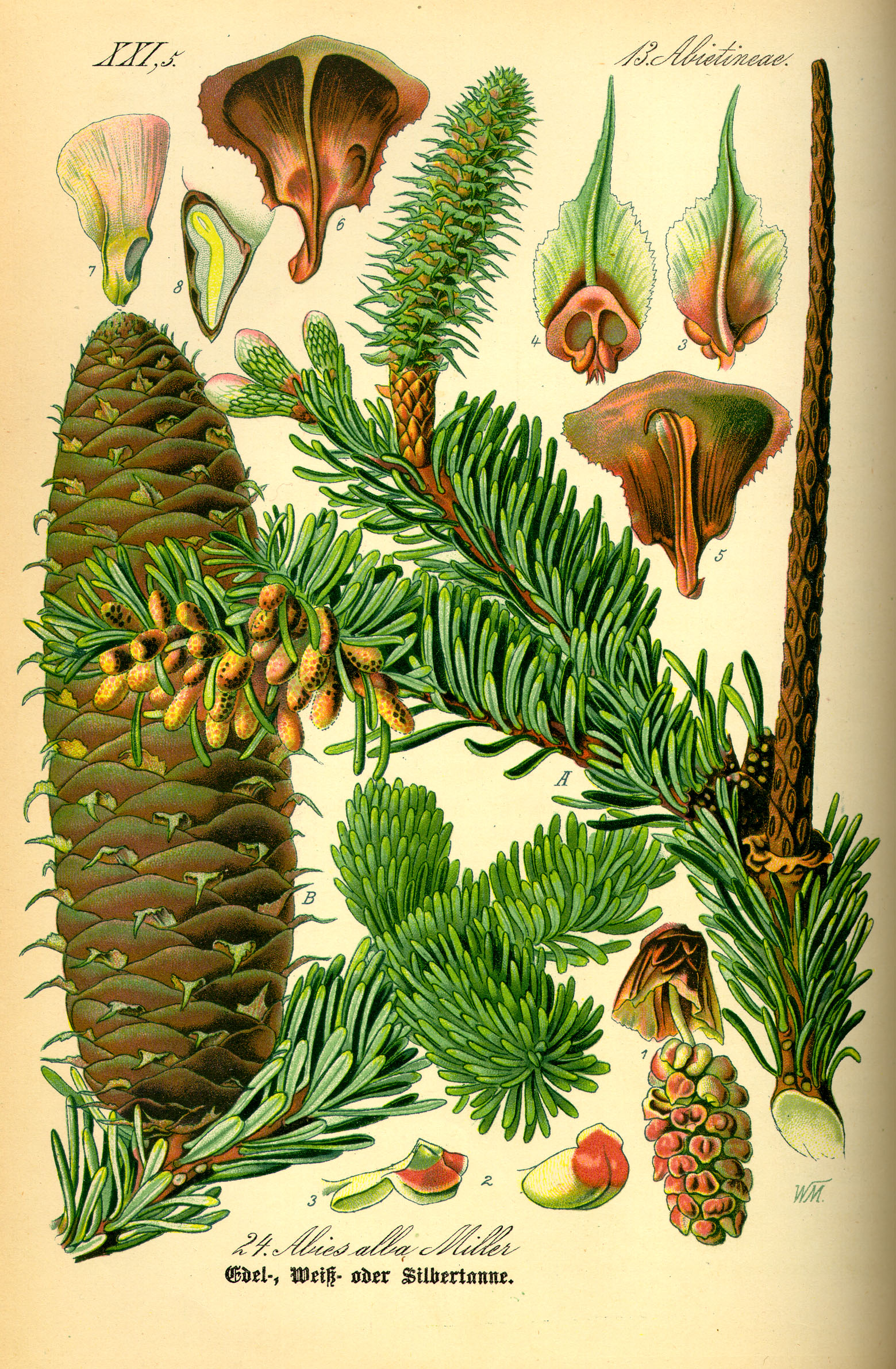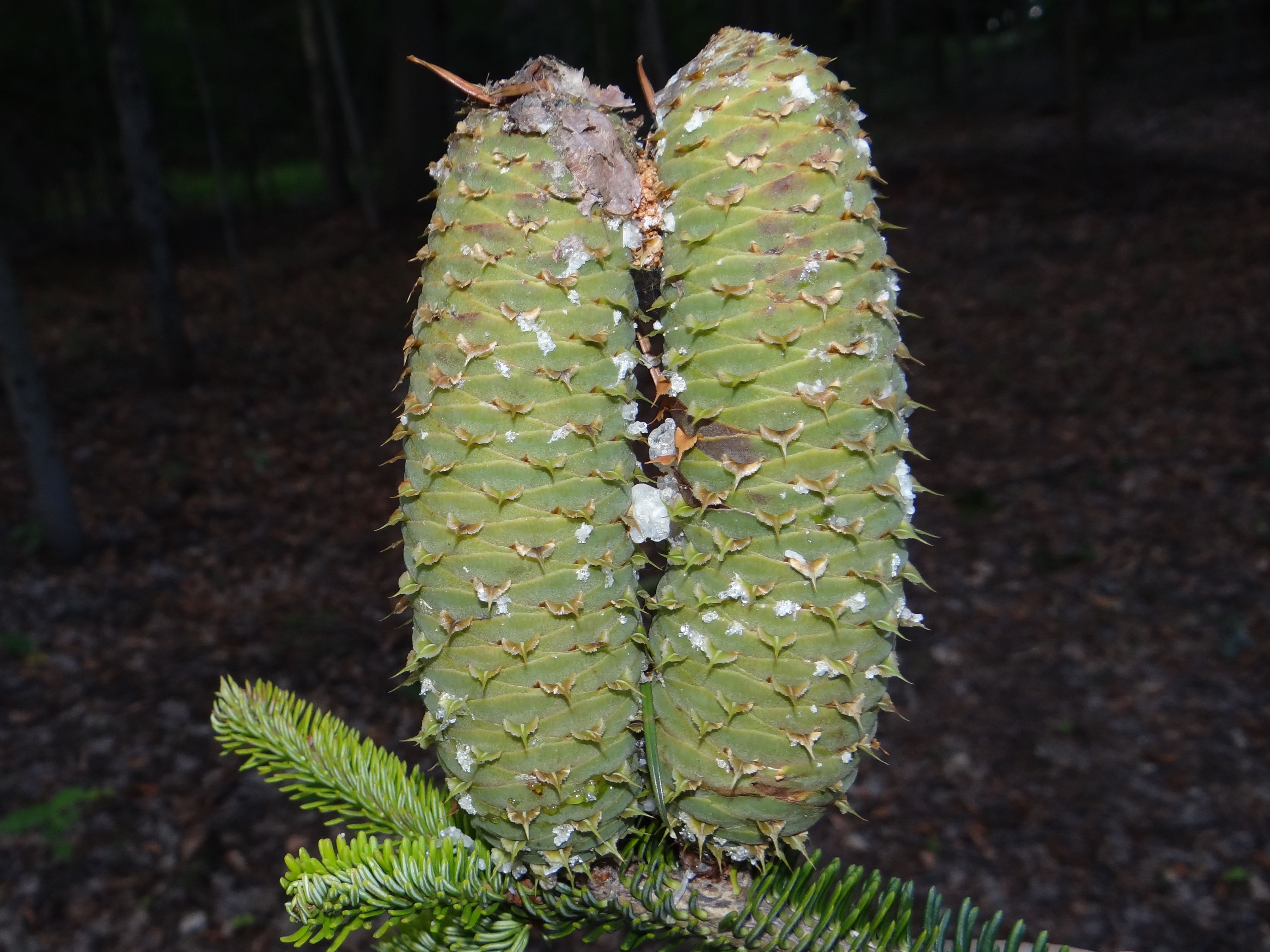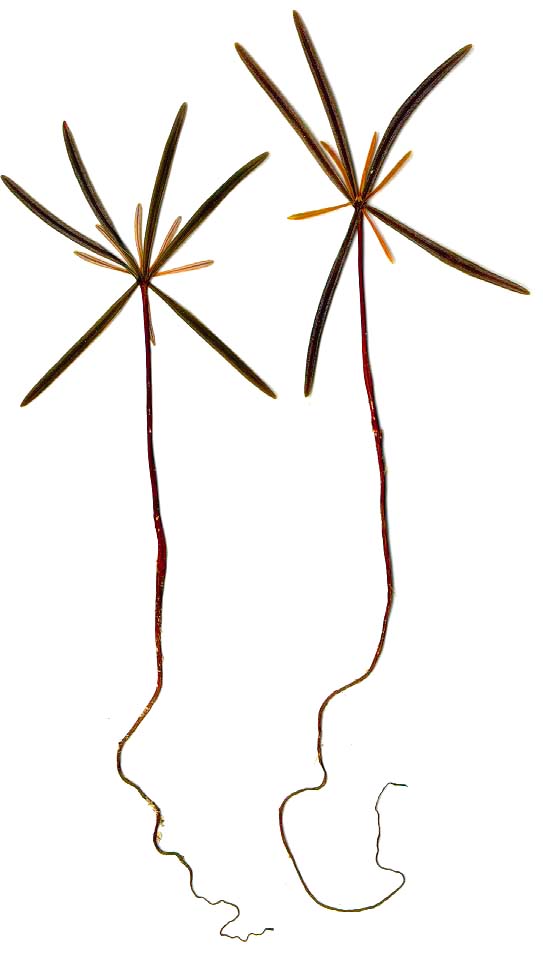Abies alba on:
[Wikipedia]
[Google]
[Amazon]
''Abies alba'', the European silver fir or silver fir, is a fir native to the 



conifers.org: ''Abies alba''botany.cz: ''Abies alba'' Millphotomazza.com: ''Abies alba''conifersaroundtheworld.com: Abies alba - European White Fir
pfaf.org: ''Abies alba'' Mill.monumentaltrees.com: The thickest, tallest, and oldest European silver fir trees (''Abies alba'')baumkunde.de: Weiß-Tanne (''Abies alba'')
, In German
''Abies alba''
Distribution map, genetic conservation units and related resources.
mountain
A mountain is an elevated portion of the Earth's crust, generally with steep sides that show significant exposed bedrock. Although definitions vary, a mountain may differ from a plateau in having a limited summit area, and is usually higher ...
s of Europe
Europe is a large peninsula conventionally considered a continent in its own right because of its great physical size and the weight of its history and traditions. Europe is also considered a Continent#Subcontinents, subcontinent of Eurasia ...
, from the Pyrenees
The Pyrenees (; es, Pirineos ; french: Pyrénées ; ca, Pirineu ; eu, Pirinioak ; oc, Pirenèus ; an, Pirineus) is a mountain range straddling the border of France and Spain. It extends nearly from its union with the Cantabrian Mountains to ...
north to Normandy
Normandy (; french: link=no, Normandie ; nrf, Normaundie, Nouormandie ; from Old French , plural of ''Normant'', originally from the word for "northman" in several Scandinavian languages) is a geographical and cultural region in Northwestern ...
, east to the Alps
The Alps () ; german: Alpen ; it, Alpi ; rm, Alps ; sl, Alpe . are the highest and most extensive mountain range system that lies entirely in Europe, stretching approximately across seven Alpine countries (from west to east): France, Sw ...
and the Carpathians
The Carpathian Mountains or Carpathians () are a range of mountains forming an arc across Central Europe. Roughly long, it is the third-longest European mountain range after the Urals at and the Scandinavian Mountains at . The range stretche ...
, Slovenia
Slovenia ( ; sl, Slovenija ), officially the Republic of Slovenia (Slovene: , abbr.: ''RS''), is a country in Central Europe. It is bordered by Italy to the west, Austria to the north, Hungary to the northeast, Croatia to the southeast, and ...
, Croatia
, image_flag = Flag of Croatia.svg
, image_coat = Coat of arms of Croatia.svg
, anthem = " Lijepa naša domovino"("Our Beautiful Homeland")
, image_map =
, map_caption =
, capi ...
, Bosnia and Herzegovina
Bosnia and Herzegovina ( sh, / , ), abbreviated BiH () or B&H, sometimes called Bosnia–Herzegovina and often known informally as Bosnia, is a country at the crossroads of south and southeast Europe, located in the Balkans. Bosnia and ...
, Montenegro
)
, image_map = Europe-Montenegro.svg
, map_caption =
, image_map2 =
, capital = Podgorica
, coordinates =
, largest_city = capital
, official_languages = ...
, Serbia
Serbia (, ; Serbian: , , ), officially the Republic of Serbia ( Serbian: , , ), is a landlocked country in Southeastern and Central Europe, situated at the crossroads of the Pannonian Basin and the Balkans. It shares land borders with Hu ...
, and south to Italy
Italy ( it, Italia ), officially the Italian Republic, ) or the Republic of Italy, is a country in Southern Europe. It is located in the middle of the Mediterranean Sea, and its territory largely coincides with the homonymous geographical ...
, Bulgaria
Bulgaria (; bg, България, Bǎlgariya), officially the Republic of Bulgaria,, ) is a country in Southeast Europe. It is situated on the eastern flank of the Balkans, and is bordered by Romania to the north, Serbia and North Macedo ...
, Kosovo
Kosovo ( sq, Kosova or ; sr-Cyrl, Косово ), officially the Republic of Kosovo ( sq, Republika e Kosovës, links=no; sr, Република Косово, Republika Kosovo, links=no), is a international recognition of Kosovo, partiall ...
, Albania
Albania ( ; sq, Shqipëri or ), or , also or . officially the Republic of Albania ( sq, Republika e Shqipërisë), is a country in Southeastern Europe. It is located on the Adriatic and Ionian Seas within the Mediterranean Sea and share ...
and northern Greece
Greece,, or , romanized: ', officially the Hellenic Republic, is a country in Southeast Europe. It is situated on the southern tip of the Balkans, and is located at the crossroads of Europe, Asia, and Africa. Greece shares land borders wi ...
; it is also commonly grown on Christmas tree plantations in the North East region of North America spanning New England in the US to the Maritime provinces of Canada.



Description
''Abies alba'' is a largeevergreen
In botany, an evergreen is a plant which has foliage that remains green and functional through more than one growing season. This also pertains to plants that retain their foliage only in warm climates, and contrasts with deciduous plants, whic ...
conifer
Conifers are a group of cone-bearing seed plants, a subset of gymnosperms. Scientifically, they make up the division Pinophyta (), also known as Coniferophyta () or Coniferae. The division contains a single extant class, Pinopsida. All ext ...
ous tree
In botany, a tree is a perennial plant with an elongated stem, or trunk, usually supporting branches and leaves. In some usages, the definition of a tree may be narrower, including only woody plants with secondary growth, plants that are ...
growing to tall and with a trunk diameter up to . The largest measured tree was tall and had a trunk diameter of . It occurs at altitudes of (mainly over ), on mountains with rainfall over per year.
The leaves
A leaf ( : leaves) is any of the principal appendages of a vascular plant stem, usually borne laterally aboveground and specialized for photosynthesis. Leaves are collectively called foliage, as in "autumn foliage", while the leaves, st ...
are needle-like, flattened, long and wide by thick, glossy dark green above, and with two greenish-white bands of stomata
In botany, a stoma (from Greek ''στόμα'', "mouth", plural "stomata"), also called a stomate (plural "stomates"), is a pore found in the epidermis of leaves, stems, and other organs, that controls the rate of gas exchange. The pore is b ...
below. The leaf is usually slightly notched at the tip. The cones are long and broad, with about 150-200 scales, each scale with an exserted bract and two winged seed
A seed is an embryonic plant enclosed in a protective outer covering, along with a food reserve. The formation of the seed is a part of the process of reproduction in seed plants, the spermatophytes, including the gymnosperm and angiosper ...
s; they disintegrate when mature to release the seeds. The wood is white, leading to the species name ''alba''.
When cultivated on Christmas Tree plantations, the tree naturally forms a symmetrical triangle shape. The trees are full and dense with smell of resin, and are known to be one of the longest lasting after being cut. In the forest the evergreen tends to form stands with other firs and beeches. It is closely related to Bulgarian fir (''Abies borisiiregis
''Abies borisii-regis'' (Bulgarian fir) is a species of fir native to the mountains of the Balkan Peninsula in Bulgaria, northern Greece, Kosovo, North Macedonia, Albania and Serbia. It occurs at altitudes of 800–1,800 m, on mountai ...
'') further to the southeast in the Balkan Peninsula, Spanish fir (''Abies pinsapo
''Abies pinsapo'', the Spanish fir, is a species of tree in the family Pinaceae, native to southern Spain and northern Morocco. Related to other species of Mediterranean firs, it appears at altitudes of in the Sierra de Grazalema in the Provinc ...
'') of Spain and Morocco and Sicilian fir (''Abies nebrodensis
''Abies nebrodensis'', the Sicilian fir, is a fir native to the Madonie mountains in northern Sicily.
Taxonomy
It is closely related to silver fir, ''Abies alba'', which replaces it in the Apennine Mountains of Italy and elsewhere further nor ...
'') in Sicily
(man) it, Siciliana (woman)
, population_note =
, population_blank1_title =
, population_blank1 =
, demographics_type1 = Ethnicity
, demographics1_footnotes =
, demographi ...
, differing from these and other related Euro-Mediterranean firs in the sparser foliage, with the leaves spread either side of the shoot, leaving the shoot readily visible from above. Some botanists treat Bulgarian fir and Sicilian fir as varieties of silver fir, as ''A. alba'' var. ''acutifolia'' and ''A. alba'' var. ''nebrodensis'', respectively.
Ecology
Silver fir is an important component species in the dinaric calcareous block fir forest in the westernBalkan Peninsula
The Balkans ( ), also known as the Balkan Peninsula, is a geographical area in southeastern Europe with various geographical and historical definitions. The region takes its name from the Balkan Mountains that stretch throughout the who ...
.
In Italy
Italy ( it, Italia ), officially the Italian Republic, ) or the Republic of Italy, is a country in Southern Europe. It is located in the middle of the Mediterranean Sea, and its territory largely coincides with the homonymous geographical ...
, the silver fir is an important component of the mixed broadleaved-coniferous forest of the Apennine Mountains, especially in northern Apennine. The fir prefer a cold and humid climate, in northern exposition, with a high rainfall (over 1500 mm per year). In the oriental Alps of Italy, silver firs grow in mixed forests with Norway spruce, beech, and other trees.
Its cone scales are eaten by the caterpillar
Caterpillars ( ) are the larval stage of members of the order Lepidoptera (the insect order comprising butterflies and moths).
As with most common names, the application of the word is arbitrary, since the larvae of sawflies (suborder Sy ...
s of the tortrix moth ''Cydia illutana
__NOTOC__
''Cydia illutana'' is a small moth of the family Tortricidae. It is found from western and central Europe (Great Britain, the Netherlands, Austria, Germany and France), north to Scandinavia (Denmark, Norway, Sweden and Finland) and e ...
'', while '' C. duplicana'' feeds on the bark around injuries or canker
A plant canker is a small area of dead tissue, which grows slowly, often over years. Some cankers are of only minor consequence, but others are ultimately lethal and therefore can have major economic implications for agriculture and horticultur ...
.
Chemistry and pharmacology
The bark and wood of silver fir are rich in antioxidativepolyphenol
Polyphenols () are a large family of naturally occurring organic compounds characterized by multiples of phenol units. They are abundant in plants and structurally diverse. Polyphenols include flavonoids, tannic acid, and ellagitannin, some ...
s. Six phenolic acids were identified ( gallic, homovanillic, protocatechuic, p-hydroxybenzoic, vanillic and p-coumaric), three flavonoid
Flavonoids (or bioflavonoids; from the Latin word ''flavus'', meaning yellow, their color in nature) are a class of polyphenolic secondary metabolites found in plants, and thus commonly consumed in the diets of humans.
Chemically, flavonoids ...
s ( catechin, epicatechin and catechin tetramethyl ether) and eight lignans ( taxiresinol, 7-(2-methyl-3,4-dihydroxytetrahydropyran-5-yloxy)-taxiresinol, secoisolariciresinol
Secoisolariciresinol is an organic compound. It is classified as a lignan, i.e., a type of phenylpropanoid. It is present in some cereals, e.g. rye, and together with matairesinol, has attracted much attention for its beneficial nutritional effect ...
, lariciresinol
Lariciresinol is a lignan, i.e., a type of phenylpropanoids. It is the precursor to enterolignans by the action of gut microflora. Enterolignans are of interest because they are speculated to exhibit beneficial medicinal properties.
Occurrence
...
, hydroxymatairesinol, isolariciresinol, matairesinol and pinoresinol).
The extract from the trunk was shown to prevent atherosclerosis in guinea pigs and to have cardioprotective effect in isolated rat hearts. Silver fir wood extract was found to reduce the post-prandial glycemic response (concentration of sugar in the blood after the meal) in healthy volunteers.
Uses
In Roman times the wood was used to make wooden casks to store and transport wine and other substances. A resinousessential oil
An essential oil is a concentrated hydrophobic liquid containing volatile (easily evaporated at normal temperatures) chemical compounds from plants. Essential oils are also known as volatile oils, ethereal oils, aetheroleum, or simply as the o ...
can be extracted. This pine-scented oil is used in perfumes, bath products, and aerosol inhalants. Its branches (including the leaves, bark and wood) were used for production of spruce beer
Spruce beer is a beverage flavored with the buds, needles, or essence of spruce trees. ''Spruce beer'' can refer to either alcoholic or non-alcoholic beverages.
A number of flavors are associated with spruce-flavored beverages, ranging from flo ...
.
Silver fir is the species first used as a Christmas tree
A Christmas tree is a decorated tree, usually an evergreen conifer, such as a spruce, pine or fir, or an artificial tree of similar appearance, associated with the celebration of Christmas. The custom was further developed in early modern ...
, but has been largely replaced by Nordmann fir (which has denser, more attractive foliage), Norway spruce
''Picea abies'', the Norway spruce or European spruce, is a species of spruce native to Northern, Central and Eastern Europe.
It has branchlets that typically hang downwards, and the largest cones of any spruce, 9–17 cm long. It is very close ...
(which is much cheaper to grow), and other species.
The wood
Wood is a porous and fibrous structural tissue found in the stems and roots of trees and other woody plants. It is an organic materiala natural composite of cellulose fibers that are strong in tension and embedded in a matrix of lignin ...
is strong, lightweight, light-colored, fine grained, even-textured and long fibered. The timber
Lumber is wood that has been processed into dimensional lumber, including beams and planks or boards, a stage in the process of wood production. Lumber is mainly used for construction framing, as well as finishing (floors, wall panels, w ...
is mainly used as construction wood, furniture, plywood
Plywood is a material manufactured from thin layers or "plies" of wood veneer that are glued together with adjacent layers having their wood grain rotated up to 90 degrees to one another. It is an engineered wood from the family of manufactured ...
, pulpwood
Pulpwood is timber with the principal use of making wood pulp for paper production.
Applications
* Trees raised specifically for pulp production account for 15% of world pulp production, old growth forests 9% and second- and third- and more gene ...
and paper
Paper is a thin sheet material produced by mechanically or chemically processing cellulose fibres derived from wood, rags, grasses or other vegetable sources in water, draining the water through fine mesh leaving the fibre evenly distribu ...
manufacture.
The honeydew which is produced by aphids sitting on the silver fir is collected by honey bees. The resulting honey
Honey is a sweet and viscous substance made by several bees, the best-known of which are honey bees. Honey is made and stored to nourish bee colonies. Bees produce honey by gathering and then refining the sugary secretions of plants (primar ...
is marketed as "fir honey".
Etymology
''Abies'' is derived fromLatin
Latin (, or , ) is a classical language belonging to the Italic languages, Italic branch of the Indo-European languages. Latin was originally a dialect spoken in the lower Tiber area (then known as Latium) around present-day Rome, but through ...
, meaning 'rising one'. The name was used to refer to tall trees or ships.Gledhill, David (2008). "The Names of Plants". Cambridge University Press. (hardback), (paperback). pp 32, 41
''Alba'' means 'bright' or 'dead white'.
References
*External links
conifers.org: ''Abies alba''
pfaf.org: ''Abies alba'' Mill.
, In German
''Abies alba''
Distribution map, genetic conservation units and related resources.
European Forest Genetic Resources Programme
European Forest Genetic Resources Programme (EUFORGEN) is an international network that supports the conservation and sustainable use of forest genetic resources in Europe. The programme’s tasks include to coordinate and promote '' in situ'' an ...
(EUFORGEN)
{{Authority control
alba
''Alba'' ( , ) is the Scottish Gaelic name for Scotland. It is also, in English language historiography, used to refer to the polity of Picts and Scots united in the ninth century as the Kingdom of Alba, until it developed into the Kin ...
Trees of Europe
Flora of the Alps
Flora of Spain
Flora of the Pyrenees
Flora of France
Flora of the Carpathians
Plants described in 1768
Flora of Montenegro
Taxa named by Philip Miller